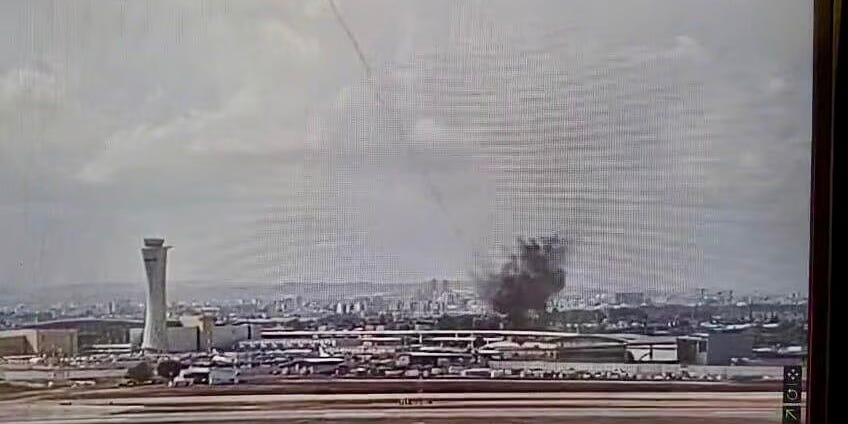Yemen's Missile Strike on Ben Gurion Changes Everything
Ballistic missile defeats US-Israeli defences — AEGIS, Patriot, Arrow, David's Sling, THAAD — strikes the world's most defended airport
Yemen’s ballistic missile strike on Ben Gurion Airport today pierced the heart of the US-Israeli defence alliance — evading Aegis-equipped US warships in the Red Sea, THAAD and Patriot missile defence batteries stationed in Persian Gulf states and Israel, and Israel’s Arrow and David’s Sling systems.
All of these missile interceptors were built by Raytheon, either outright or in partnership with Israeli firms. In short, Ansarallah has defeated, probably the largest and certainly most advanced missile shield ever fielded by the US and Israel, not to mention the best and brightest at Raytheon.
Israel’s army radio confirmed that both THAAD and Arrow interceptors were launched at the incoming Yemeni ballistic missile but failed to hit the target.
Today’s successful ballistic missile strike, together with Iran’s precision strikes on Israel’s Nevatim air base last year, lays bare the vulnerability of the US-Israeli layered missile shield — it’s designed to intercept at every stage of a ballistic missile’s flight — AEGIS warships for boost-phase kills, THAAD batteries tracking midcourse arcs, and terminal kinetic interceptor systems like Arrow-3 and David’s Sling for anything that makes it to the final descent.
The failure of these systems is all the more inexplicable, as they weren’t defending against peer rivals but against the arsenals of a sanctioned middle-income state, Iran, and a war-ravaged, starved, and besieged Yemen — bombed relentlessly with US ordnance for over a decade.
Yet today, Yemen launched its 27th missile at Israel in six weeks — forcing millions into shelters and striking inside the perimeter of Ben Gurion International Airport. The missile blasted a 25-metre-deep crater near aircraft parked outside the arrivals terminal, injuring several and grounding all air traffic.
Incoming and outgoing flights were suspended, international airlines cancelled flights to Tel Aviv, and an Air India flight was forced to abort its landing. An Israeli cabinet meeting scheduled for today was cancelled, with the security cabinet instead convening an emergency session — forcing Netanyahu to postpone a planned visit to Azerbaijan.
The missile struck shortly after air raid sirens began — and before they had stopped, raising the obvious questions: how did it evade a phalanx of advanced interceptors — AEGIS, THAAD, Arrow, and David’s Sling — deployed in the Red Sea and across multiple countries along the missile’s trajectory, and why wasn’t there more warning?
Particularly given that the US and Gulf Cooperation Council (GCC) states have only recently enhanced their Integrated Air and Missile Defence (IAMD) systems and operational coordination — upgrades specifically designed to intercept threats like Yemen’s missile long before it reached Israel, alongside the stationing of additional Patriot and THAAD interceptors within Israel.
And let’s not forget, the US-UK-Israel military trifecta has been carpet-bombing Yemen, with over 1,000 air strikes since March alone. Yet Yemen’s military capability remains intact — it continues to launch missiles and drones at US ships in the Red Sea and at Israel, and regularly downs MQ-9 Reaper drones flying reconnaissance missions over its territory.
As Larry Johnson explains — “ The truth of the matter is that old Uncle Sam has an impotence problem. Locating and destroying mobile missile platforms is a daunting task, especially in the rugged terrain of Yemen. After seven weeks of bombing the Houthis, Uncle Sam’s carrier strike group has failed to quell the Houthis. Not that the US had a great reputation to begin with, but the bombing of civilian targets inside Yemen, which has produced scores of dead women and children, is only fuelling greater hatred of the United States”.
Israeli Defence Minister Katz's assertion that Israel will ‘hit Yemen back tenfold’ holds no fear for Ansarallah. Israeli newspaper Hayom spelled out the apparent — “Israel faces a strategic dilemma in confronting the Yemeni challenge, despite the US air campaign”.
That’s because Yemen has imposed a de facto sea blockade on Israeli-bound shipping in the Red Sea — and now, by targeting airports, an air blockade as well.
The Yemeni Armed Forces issued the following statement —
We targeted Ben Gurion Airport…with a hypersonic ballistic missile.
We are warning airlines flying through Ben Gurion Airport of the dangers facing their planes, as this is a target for our missiles until the aggression against Gaza stops and the siege on it is lifted.
The results of the operation are as follows:
Failure of the "American" and "Israeli" interception systems to stop the missile.
More than three million [Israeli’s] fleeing to shelters.
Complete suspension of airport operations.
And Ansarallah’s leader, Mohammed Al-Bukhaiti, followed up — “The bombing of Ben Gurion Airport is evidence of our ability to target fortified sites inside [Israel] and there are no red lines in our confrontation with [Israel], America, and Britain.
Washington quickly retaliated to the strike on Ben Gurion with 35 air strikes across Yemen.
Beyond the obvious commercial impact — not least insurers demanding eye-watering risk premiums from international carriers braving flights into Israel — this latest strike only reaffirms what was already clear — Raytheon missile interceptors, whether they are branded THAAD, Patriot, Arrow or David’s Sling — simply aren’t up to the job, much like the F35 fighter or Abrams tank, they reek of yet another Pentagon procurement boondoggle. The US and its allies were sold yet another pup.
But more than this, the Persian Gulf monarchies will be under no illusion — their oil and gas infrastructure, desalination plants and military bases are, in effect, defenceless against Yemeni or Iranian missiles. Surreptitiously allowing the US to launch attacks from their territory — Yemen today, Iran tomorrow — carries an existential risk.
US–Iran nuclear negotiations — already in troubled waters — will now take another hit. Washington has accused Iran of supplying Yemen with the intelligence and technical support to develop, launch, and accurately target long-range missiles. Israeli-firsters in the Trump administration, backed by Netanyahu, will be straining at the leash to secure the green-light for direct US military action against Iran.
Recall that US Defence Secretary Pete Hegseth recently accused Iran of arming the Houthis, warning there would be consequences. Tehran denied the claims. Washington, however, rolled out sweeping sanctions last week on countries buying Iranian oil or petrochemicals — a move seemingly aimed as much at Beijing, Iran’s largest oil customer, as at Tehran itself.
But Sana’a’s strike on Ben Gurion also reminds Washington that reality bites — walk away from a balanced nuclear deal and attack Iran and the price will be very high.
Regardless, Israeli ministers are also shouting from the rafters for retaliation. But the hard truth is this — Israel has no effective defence against ballistic missile strikes. Even though Yemen only wants the lifting of the siege on Gaza and the unimpeded flow of humanitarian aid, when this happens, missile strikes cease immediately.
By contrast, what Netanyahu wants — and has wanted for more than two decades — is for Washington to expend vast amounts of blood and treasure bombing Iran back to the middle ages, extending Israel’s regional hegemony well past its sell by date.
Just days ago we learnt that former National Security Advisor Mike Waltz — an ardent Israeli-firster and Iran hawk — was essentially shown the door, because he seemed to be batting for the Israeli team.
The Washington Post reports that Waltz met Netanyahu just before his meeting with Trump last month — “The view by some in the administration was that Waltz was trying to tip the scales in favour of military action and was operating hand in glove with the Israelis”. Bluntly, a senior US official was ousted for colluding with a foreign power to drag America into yet another Middle East war.
Alas, we know, Yemen’s missile strike on Ben Gurion exposes a security architecture built to shield Western and Israeli interests — not to provide sovereign nations with collective regional security. AEGIS, THAAD, and Patriot batteries parked across the region aren’t about regional stability — they’re there to uphold a militarised pecking order.
Targeting Ben Gurion echoes a familiar pattern — weaker states forced into asymmetrical tactics to hit back at oppressive powers.
The failure of US–Israeli interceptors underscores the mismatch — multi-billion-dollar tech flailing against low-cost, rapidly adapted weapons. Western alliances (US–GCC–Israel) keep throwing high-end, so called cutting-edge hardware at the symptoms, whilst at the same time being wholly or partly responsible, for the root causes of conflict in Yemen, Palestine, and Syria, and worse, actively perpetuating them. Arms suppliers cash in — as the region stumbles towards the abyss.
The media will doubtless frame the failure to intercept Yemen’s missile strike as a technical issue. It’s not. It’s the failure of over-hyped, exorbitantly expensive, missile defence systems and a US-imposed security architecture that fragments the region by design.
Iran’s support for Yemeni missile tech isn’t new — it mirrors Cold War logic. Arm others and dodge direct war. Even so, it remains axiomatic that Yemen’s devastation was engineered in Washington, London, West Jerusalem, and Riyadh.
Don’t expect the media to link Yemen’s missile strike on Ben Gurion to Gaza, or to the broader Palestinian fight for self-determination. The structural violence bludgeoning the life out of Palestine, Lebanon, Syria, and Yemen is all part of the same imperial game — trying, and failing, to prop up a regional enforcer that’s looking more and more like a failing state.
This wasn’t just a breach of air defences. It’s the region coming apart at the seams.
The rationale way forward? Dismantle the colonial scaffolding and allow the region to build its own security architecture. But first, a reckoning of sorts appears all but certain.





What is definitely not needed is sports-like fandom articles taking pleasure in deaths from the bleachers.
Alarmist biased twaddle. No defense can stop everything. How many targets has Ukraine hit in Russia in last 2 years w homemade drones? Against vaunted S-300 and S-400 systems? So what we have here is one successful hit. Good for Yemen, but it augurs nothing. Yemen doesnt hold because its stronger or morally better, but because no determined force can be defeated just from the air and the West wont invade it.
On American and Western equipment, its sometimes better and sometimes worse than what Russia/Iran/China have. Patriots have proven themselves in Ukraine. Abrams hasnt done much, but what can 20 tanks used in most drone heavy battlefield in history even teach us? Bradleys have died on mines and drones but also easily destroyed T-90s. Its war, there will be losses and there will be mistakes. Thats it. Lets hope we never really have to find out who has a better armed forces between China and US. Not sure we would live to settle that one.